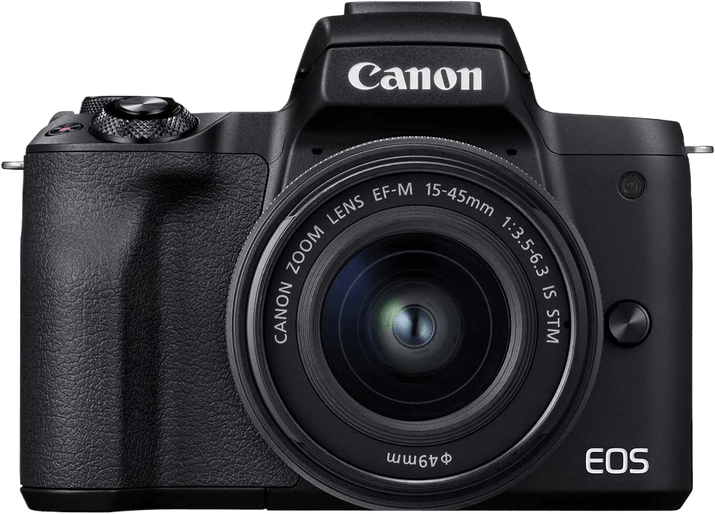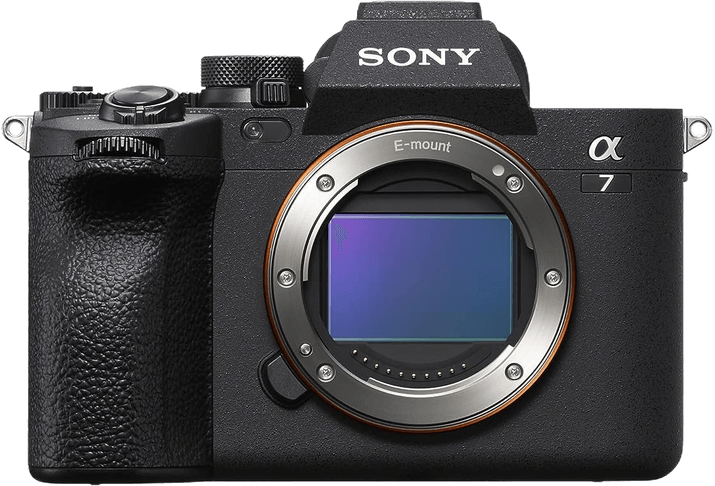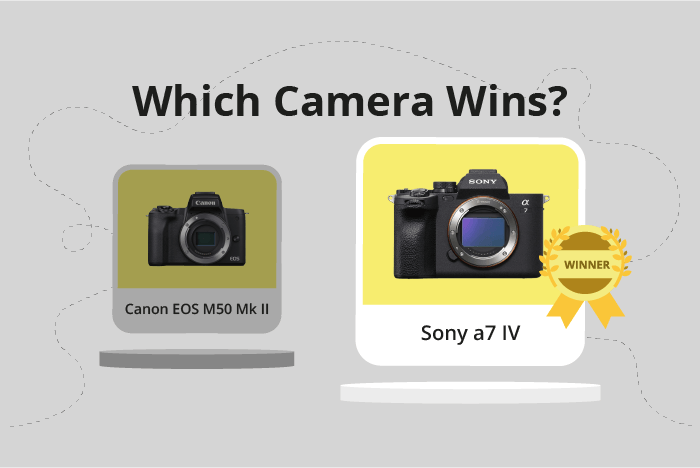Canon EOS M50 Mark II vs Sony a7 IV Comparison
Canon EOS M50 Mark II

Sony a7 IV

The Sony a7 IV outperforms the Canon EOS M50 Mark II with a score of 84/100 compared to 59/100. Both cameras are mirrorless models released in 2020 and 2021, respectively. They have similar design elements, with the Canon being smaller and lighter, measuring 116 x 88 x 59mm and weighing 387g, while the Sony measures 131 x 96 x 80mm and weighs 659g.
The Sony a7 IV is superior in terms of performance, as reflected in its higher score. However, the Canon EOS M50 Mark II has its advantages, particularly its compact size and lighter weight, making it more portable and convenient for casual users. The Sony a7 IV comes with a heftier price tag at $2499 compared to the Canon’s $750, but its advanced features and higher score justify the investment for serious photographers.
Ultimately, the Sony a7 IV proves to be the better camera for professionals, while the Canon EOS M50 Mark II is ideal for those seeking a more affordable and portable option without compromising on quality.
Canon EOS M50 Mark II vs Sony a7 IV Overview and Optics
The Sony a7 IV surpasses the Canon EOS M50 Mark II in optics, scoring 85 out of 100 compared to the Canon’s 59. Both cameras possess 10 fps shooting speed, CMOS sensors, and lens mounts compatible with their respective brands. However, the Sony a7 IV outperforms the Canon EOS M50 Mark II in several aspects.
The Sony a7 IV has a higher megapixel count at 33, while the Canon EOS M50 Mark II has 24 megapixels. This difference allows the Sony a7 IV to capture more detail and produce higher resolution images. The Sony a7 IV also has a more advanced processor, the Bionz XR, compared to the Canon’s Digic 8. A better processor contributes to faster image processing and improved overall performance.
Furthermore, the Sony a7 IV has a full-frame sensor, while the Canon EOS M50 Mark II has an APS-C sensor. A full-frame sensor provides better low-light performance, increased dynamic range, and shallower depth of field. The Sony a7 IV also has a higher DXOMARK sensor score at 97, compared to the Canon’s 58. This score reflects the sensor’s overall image quality. Additionally, the Sony a7 IV features image stabilization, which the Canon EOS M50 Mark II lacks. Image stabilization helps reduce camera shake and improve image sharpness in handheld shooting situations.
The Canon EOS M50 Mark II does not have any significant advantages over the Sony a7 IV in terms of optics. Given the differences in sensor size, megapixels, processor, and image stabilization, the Sony a7 IV proves to be a better camera in this comparison. Potential buyers should consider these factors when choosing between the two cameras.
Canon EOS M50 Mark II vs Sony a7 IV Video Performance
The Canon EOS M50 Mark II and the Sony a7 IV both have a video score of 91/100, making them equal contenders in video capabilities. Both cameras share common specifications, such as a maximum video resolution of 4K, video dimensions of 3840 x 2160, a maximum video frame rate of 120fps, and built-in time-lapse functionality.
Despite having identical scores, there are areas where one camera outperforms the other. The Sony a7 IV excels in its low light performance and dynamic range, making it a better choice for shooting in challenging lighting conditions. Additionally, the a7 IV has a larger sensor than the M50 Mark II, allowing for better overall image quality and improved depth of field control.
On the other hand, the Canon EOS M50 Mark II has a more user-friendly interface, making it easier for beginners to navigate and adjust settings. The M50 Mark II also has a more compact and lightweight design, making it a more convenient option for travel and on-the-go shooting.
When comparing the video capabilities of the Canon EOS M50 Mark II and the Sony a7 IV, both cameras have impressive features and performance. The Sony a7 IV is the better choice for those needing superior low light performance and image quality, while the Canon EOS M50 Mark II is ideal for beginners and those who prioritize portability.
Canon EOS M50 Mark II vs Sony a7 IV Features and Benefits
The Sony a7 IV outperforms the Canon EOS M50 Mark II in features, earning a score of 83/100 compared to the Canon’s 70/100. Both cameras share several specifications, which include a 3-inch screen size, 1040000-dot screen resolution, touchscreen, flip screen, absence of GPS, and the presence of both WIFI and Bluetooth connectivity.
The Sony a7 IV’s higher feature score reveals its superiority in various aspects. Although both cameras share common features, the Sony a7 IV offers additional capabilities and enhancements that contribute to its higher score. These enhancements provide users with a more versatile and advanced photography experience, enabling them to capture high-quality images in various conditions and settings.
On the other hand, the Canon EOS M50 Mark II does not surpass the Sony a7 IV in any particular feature. However, it still provides a decent set of features that cater to a wide range of photography enthusiasts, from beginners to more experienced users. The Canon EOS M50 Mark II remains a reliable option for those who prioritize the brand or are already familiar with Canon’s ecosystem.
In comparing the two cameras, the Sony a7 IV proves to be the better choice due to its higher feature score and additional capabilities. Meanwhile, the Canon EOS M50 Mark II remains a viable option for those who prefer the Canon brand or seek a more affordable alternative. Ultimately, the choice between these two cameras depends on individual preferences, requirements, and budget constraints.
Canon EOS M50 Mark II vs Sony a7 IV Storage and Battery
The Sony a7 IV outperforms the Canon EOS M50 Mark II in storage and battery, scoring 76 points compared to Canon’s 21. Both cameras accept SD memory cards, but the Sony a7 IV has two memory card slots and is also compatible with CFexpress Type A and UHS-II SD cards, offering more versatility in storage options. The Canon EOS M50 Mark II only has one memory card slot and is compatible with UHS-I SD cards.
The Sony a7 IV’s battery life is significantly longer, providing 580 shots compared to the Canon EOS M50 Mark II’s 305 shots. Additionally, the Sony a7 IV uses the NP-FZ100 battery and supports USB charging, making it more convenient for extended use. The Canon EOS M50 Mark II relies on the LP-E12 battery and does not support USB charging.
While the Canon EOS M50 Mark II has a lower score in this category, it still offers adequate storage and battery life for casual photographers or beginners. However, the Sony a7 IV’s superior storage options, longer battery life, and USB charging capability make it a better choice for professional photographers or those who require more flexibility and endurance in their camera equipment.
Canon EOS M50 Mark II vs Sony a7 IV – Our Verdict
Are you still undecided about which camera is right for you? Have a look at these popular comparisons that feature the Canon EOS M50 Mark II or the Sony a7 IV:

